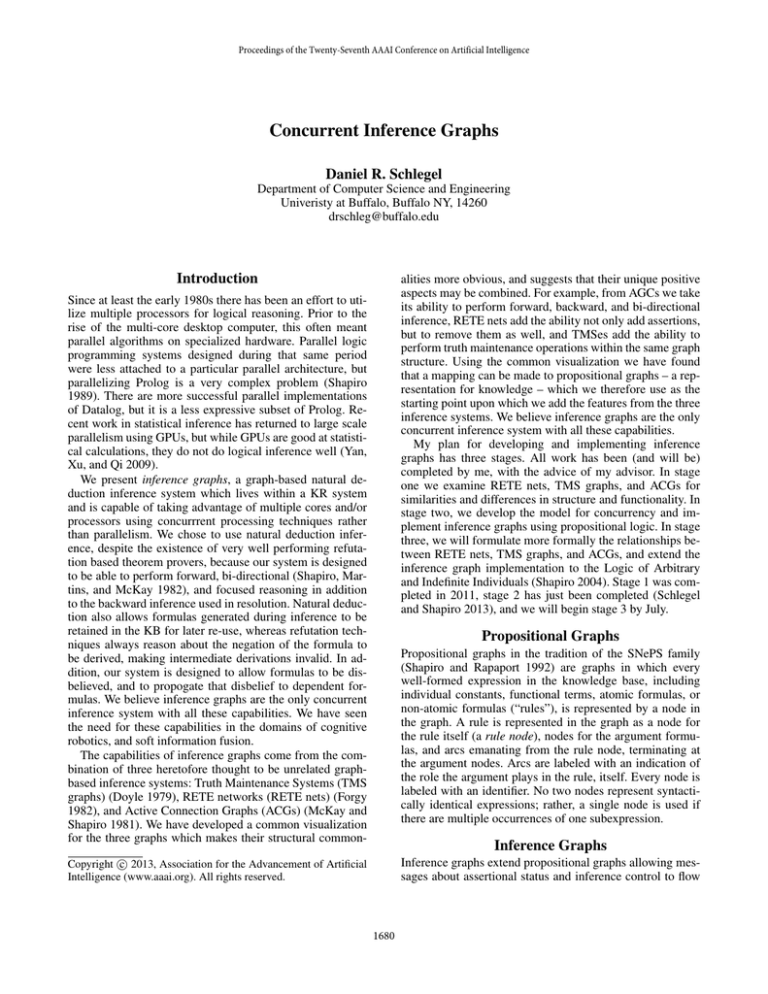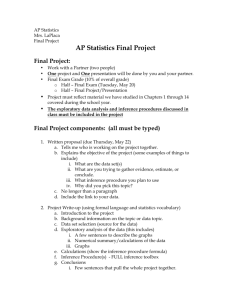
Proceedings of the Twenty-Seventh AAAI Conference on Artificial Intelligence
Concurrent Inference Graphs
Daniel R. Schlegel
Department of Computer Science and Engineering
Univeristy at Buffalo, Buffalo NY, 14260
drschleg@buffalo.edu
Introduction
alities more obvious, and suggests that their unique positive
aspects may be combined. For example, from AGCs we take
its ability to perform forward, backward, and bi-directional
inference, RETE nets add the ability not only add assertions,
but to remove them as well, and TMSes add the ability to
perform truth maintenance operations within the same graph
structure. Using the common visualization we have found
that a mapping can be made to propositional graphs – a representation for knowledge – which we therefore use as the
starting point upon which we add the features from the three
inference systems. We believe inference graphs are the only
concurrent inference system with all these capabilities.
My plan for developing and implementing inference
graphs has three stages. All work has been (and will be)
completed by me, with the advice of my advisor. In stage
one we examine RETE nets, TMS graphs, and ACGs for
similarities and differences in structure and functionality. In
stage two, we develop the model for concurrency and implement inference graphs using propositional logic. In stage
three, we will formulate more formally the relationships between RETE nets, TMS graphs, and ACGs, and extend the
inference graph implementation to the Logic of Arbitrary
and Indefinite Individuals (Shapiro 2004). Stage 1 was completed in 2011, stage 2 has just been completed (Schlegel
and Shapiro 2013), and we will begin stage 3 by July.
Since at least the early 1980s there has been an effort to utilize multiple processors for logical reasoning. Prior to the
rise of the multi-core desktop computer, this often meant
parallel algorithms on specialized hardware. Parallel logic
programming systems designed during that same period
were less attached to a particular parallel architecture, but
parallelizing Prolog is a very complex problem (Shapiro
1989). There are more successful parallel implementations
of Datalog, but it is a less expressive subset of Prolog. Recent work in statistical inference has returned to large scale
parallelism using GPUs, but while GPUs are good at statistical calculations, they do not do logical inference well (Yan,
Xu, and Qi 2009).
We present inference graphs, a graph-based natural deduction inference system which lives within a KR system
and is capable of taking advantage of multiple cores and/or
processors using concurrrent processing techniques rather
than parallelism. We chose to use natural deduction inference, despite the existence of very well performing refutation based theorem provers, because our system is designed
to be able to perform forward, bi-directional (Shapiro, Martins, and McKay 1982), and focused reasoning in addition
to the backward inference used in resolution. Natural deduction also allows formulas generated during inference to be
retained in the KB for later re-use, whereas refutation techniques always reason about the negation of the formula to
be derived, making intermediate derivations invalid. In addition, our system is designed to allow formulas to be disbelieved, and to propogate that disbelief to dependent formulas. We believe inference graphs are the only concurrent
inference system with all these capabilities. We have seen
the need for these capabilities in the domains of cognitive
robotics, and soft information fusion.
The capabilities of inference graphs come from the combination of three heretofore thought to be unrelated graphbased inference systems: Truth Maintenance Systems (TMS
graphs) (Doyle 1979), RETE networks (RETE nets) (Forgy
1982), and Active Connection Graphs (ACGs) (McKay and
Shapiro 1981). We have developed a common visualization
for the three graphs which makes their structural common-
Propositional Graphs
Propositional graphs in the tradition of the SNePS family
(Shapiro and Rapaport 1992) are graphs in which every
well-formed expression in the knowledge base, including
individual constants, functional terms, atomic formulas, or
non-atomic formulas (“rules”), is represented by a node in
the graph. A rule is represented in the graph as a node for
the rule itself (a rule node), nodes for the argument formulas, and arcs emanating from the rule node, terminating at
the argument nodes. Arcs are labeled with an indication of
the role the argument plays in the rule, itself. Every node is
labeled with an identifier. No two nodes represent syntactically identical expressions; rather, a single node is used if
there are multiple occurrences of one subexpression.
Inference Graphs
Inference graphs extend propositional graphs allowing messages about assertional status and inference control to flow
c 2013, Association for the Advancement of Artificial
Copyright Intelligence (www.aaai.org). All rights reserved.
1680
left side of the graph to the right side of the graph. Every
inference operation begins processing messages some number of levels to the left of the query node. Since there are a
limited number of tasks which can be running at once due to
hardware limitations, we must prioritize their execution, and
remove tasks which are no longer necessary. Therefore,
through the graph. Certain arcs and certain reverse arcs already within the propositional graph are augmented with
ACG-like channels through which information can flow.
Channels flow from antecedents to rule nodes, from rule
nodes to consequents, and from consequents to unifiable antecedents, where the latter act like the RETE alpha network
– filtering incompatible messages. To control the flow of
messages, channels have valves which can be either open or
closed. When a valve is open, messages flow freely forward,
but when it is closed they wait behind it. Rule nodes in inference graphs combine messages and carry out introduction
and elimination rules to determine if itself or its consequents
are true or negated – meaning the inference graph is both a
representation of knowledge and the method for performing
inference upon it.
Messages come in several types, each serving one of two
purposes: relaying newly derived information, and controlling the inference process. A message can be sent to relay the
information that its origin has been asserted or negated, that
its destination should now be asserted or negated, or that its
origin has either just become unasserted or is no longer sufficiently supported. Messages used to relay newly derived
information carry a support set with them for truth maintenance similar to that of the ATMS (a type of TMS) (de
Kleer 1986). Other messages travel backward along channels opening and closing valves to control the inference process. This second kind of message allows for backward and
bi-directional inference, along with cancellation of unnecessary inference processes.
Inference operations take place in the rule nodes. When
a message arrives at a rule node the message is translated
into a RUI. RUIs contain information about how many (and
specifically which) antecedents of a rule are known to be
true or false, along with a set of support. All RUIs created at
a node are cached. These RUIs are combined to determine
if the rule node’s inference rules can be applied – much like
the RETE beta network. The RUI cache can also be used
to prevent re-derivations and cut cycles. Our approach does
make some rules difficult to implement, such as negation
introduction, and proof by cases. For us, the advantages in
capability outweigh the difficulties of implementation.
1. tasks for relaying newly derived information using segments to the right execute before those to the left, and
2. once a node is known to be true or false, all tasks attempting to derive it (left of it in the graph) are canceled, as
long as their results are not needed elsewhere.
Together, these two heuristics ensure that messages reach
the query as quickly as possible, and time is not wasted deriving unnecessary formulas. The priorities of the messages
(and hence, tasks) allow us to reach these goals.
To evaluate our progess, we have run tests to determine
the speedup given by the concurrency model, and by the
heuristics described in the propositional case. Tests show
that these heuristics in the propositional case result in a 1040x speed increase over various non-prioritized queues, and
when ignoring the intrinsically sequential portions of inference, nearly linear speedup with the number of processors.
References
de Kleer, J. 1986. Problem solving with the ATMS. Artif Intell
28(2):197–224.
Doyle, J. 1979. A truth maintenance system. Artif Intell 19:231–
272.
Forgy, C. 1982. Rete: A fast algorithm for the many pattern/many
object pattern match problem. Artif Intell 19:17–37.
McKay, D. P., and Shapiro, S. C. 1981. Using active connection
graphs for reasoning with recursive rules. In Proc. IJCAI-7, 368–
374. Los Altos, CA: Morgan Kaufmann.
Schlegel, D. R., and Shapiro, S. C. 2013. Concurrent reasoning
with inference graphs (student abstract). In Proc. AAAI-13 (this
volume).
Shapiro, S. C., and Rapaport, W. J. 1992. The SNePS family. Comp
Math Appl 23(2–5):243–275. Reprinted in Lehmann, F. 1992. Semantic Networks in Artificial Intelligence. Pergamon Press.
Shapiro, S. C.; Martins, J. P.; and McKay, D. P. 1982. Bidirectional inference. In Proc. CogSci-4, 90–93.
Shapiro, E. 1989. The family of concurrent logic programming
languages. ACM Comput. Surv. 21(3):413–510.
Shapiro, S. C. 2004. A logic of arbitrary and indefinite objects.
In Dubois, D.; Welty, C.; and Williams, M., eds., Proc. KR2004,
565–575. Menlo Park, CA: AAAI Press.
Yan, F.; Xu, N.; and Qi, Y. 2009. Parallel inference for latent
dirichlet allocation on graphics processing units. In Proc. NIPS,
2134–2142.
Concurrent Reasoning
To perform inference concurrently, the inference graph is
divided into inference segments (henceforth, segments). A
segment represents the inference operation – from receipt of
a message to sending new ones – which occurs in a node.
Valves delimit segments. When a message passes through
an open valve a new task is created – the application of the
segment’s inference function to the message. When tasks are
created they enter a global prioritized queue, where the priority of the task is the priority of the message. When the task
is executed, inference is performed as described above, and
any newly generated messages are sent toward its outgoing
valves for the process to repeat.
If we arrange an inference graph so that a user’s request
(in backward inference) is on the right, and channels flow
(where possible, cycles can exist) from left to right, we can
see the goal of inference as trying to get messages from the
This work has been supported by a Multidisciplinary University Research Initiative (MURI) grant (Number W911NF-09-10392) for Unified Research on Network-based Hard/Soft Information Fusion, issued by the US Army Research Office (ARO) under
the program management of Dr. John Lavery.
1681







